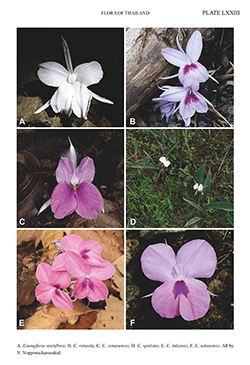e-Flora of Thailand
Volume 16 > Part 2 > Year 2023 > Page 634 > Zingiberaceae > Kaempferia
26. Kaempferia rotunda L.wfo-0000452039
Sp. Pl. 1: 3. 1753; Roxb., Fl. Ind. 1: 15. 1820; Roscoe, Monandr. Pl. Scitam.: t. 97. 1824; Horaninow, Prodr. Monogr. Scitam.: 21. 1862; Schumann, Pflanzenr. IV, 46 (Heft 20): 87. 1904; Gagnep., Fl. Indo-Chine 6(1): 47. 1908; Holttum, Gard. Bull. Singapore 13: 121. 1950; Wu & Larsen, Flora of China 24: 368. 2000; Sabu, Zingiberaceae Costaceae S. India: 215. 2007; Leong-Škorničková & Newman, Gingers of Cambodia, Laos and Vietnam: 205. 2015; Insisiengmay et al., Taxon 67(1): 207. 2018. Plate LXXIII: B.
Accepted Name : This is currently accepted.
Synonyms & Citations :
Description : Perennial herb 18–48(–70) cm tall; rhizome subglobose to ovoid, 1.6–2.8(–3.5) by 1.3–2.5(–3) cm, with fascicled fibrous roots 3–15 cm long, developing terminal tubers; tubers globose, ovoid, ellipsoid to fusiform, 1.5–3.5 by 1.2–2 cm. Leafy shoot with 4–7 leaves; pseudostem erect, 7–30 cm tall; bladeless leaf sheaths 5–13 cm long, green, reddish to tinged purplish red, apex rounded, usually sparsely villous; ligule bilobed, lobes broadly triangular, 1–3(–6) mm long, translucent, greenish white, reddish to purplish red, sparsely villous; blades lanceolate-oblong, elliptic to ovate, 16–48(–60) by 6–19 cm, margin with white to light purplish red band, above light green to dull green, usually with white, silver to light green variegated pattern, rarely with tinged purplish red to deep purple patch towards midvein, usually glabrous, below light green to tinged purplish red, sparsely villous, base acute, attenuate to obtuse, apex acute to attenuate; petiole subsessile to 9 cm long, green to tinged purplish red, sparsely villous. Inflorescence lateral, emerging from rhizome before leafy shoot, fusiform-ovoid, 4–6 by 1.5–2 cm; peduncle subsessile to 9 cm long, usually sparsely villous; bracts broadly ovate to lanceolate-ovate, 1.5–4 by 1.2–2 cm, cream to light green, sparsely villous; bracteoles lanceolate, 1.3–2.5 by 0.6–1 cm, glabrous. Flowers diurnal; floral plane perpendicular; pistil 6–7.5(–10.4) cm long; ovary cylindrical, 4–7 by 1.5–3.4 mm, cream, glabrous, occasionally sparsely villous; style 5.5–7(–9.6) cm long; stigma crateriform, 1.2–1.8 by ca 0.5 mm, ostiole ciliate; epigynous glands filiform, 2–5.5 mm long, cream; calyx 4.5–6.8 by 0.3–0.6 cm, with unilateral incision 1–1.5 cm long from apex, semitranslucent white to greenish white, rarely reddish, sometimes with brownish red veins from apex, glabrous, occasionally sparsely villous at apex; floral tube 4.8–6.5(–8.6) by 0.2–0.3(–0.4) cm, white, glabrous, dorsal corolla lobe lanceolate-oblong, 3.4–6.8 by 0.4–0.9 cm, apex mucronate, mucro 2–6 mm long, white, glabrous, lateral corolla lobes lanceolate-oblong, 3–6.4 by 0.3–0.6 cm, apex acute to mucronate, mucro 1–3 mm long, white, glabrous; lateral staminodes narrowly obovate, elliptic, oblanceolate to oblong, (3–)3.6–4.6(–5.8) by (1.3–)1.6–2.2 cm, apex rounded, acute to slightly crenate, white to pale purple; labellum obdeltoid to broadly obovate, (2.5–)3.3–5.3 by (2–)3–4.2 cm, bilobed, with incision around half of labellum length, base flat, lobes obovate to elliptic, (1.6–)2–2.7 by (1.2–)1.6–2.2 cm, apex rounded, acute to emarginate, white, light pink to pale purple, with central white to cream-white patch basally surrounded by two deep purple stripes from base towards centre, sometimes purple distally including entire area of lobes; stamen 1.2–2.3 cm long, filament (1.5–)2–3 by 1.5–2.5 mm; anther thecae (4–)6–8 by 1–1.8 mm, anther crest oblong to ovate, (4–)8–14 by 3–6.6 mm, apex bilobed, usually with 2–3 small teeth between lobes, apex of each lobe acute. Fruit cylindrical, ellipsoid to subglobose, 2.2–2.5 by 0.8–1.3 cm, green to brownish purple, glabrous, occasionally sparsely villous; seeds obovoid to ellipsoid, 4–7 by 2–3 mm, green to pale brown with deep purple spots.
Thailand : NORTHERN: Mae Hong Son (Khun Yuam, Mae Sariang); Chiang Mai (Chom Thong, Chiang Dao, Doi Saket, Mae On, Mae Rim, Mae Taeng, Mae Wang, San Sai); Chiang Rai (Wiang Pa Pao); Phayao; Nan (Bo Kluea); Lamphun (Mae Tha); Lampang (Chae Hom, Thoen); Phrae (Rong Kwang); Uttaradit (Thong Saen Khan – type of Kaempferia kamolwaniae: Picheansoonthon & Meechonkit 40616-1, holo -BK), Tak (Mae Sot, Phop Phra, Umphang); Phitsanulok (Wang Thong); Kamphaeng Phet (Khlong Lan, Kosamphi, Pang Sila Thong, Phran Kratai); Nakhon Sawan (Mae Wong); NORTH-EASTERN: Phetchabun (Chon Daen, Khao Kho, Nam Nao); Loei (Pha Khao, Phu Kradueng); Sakon Nakhon (Phu Phan); Kalasin (Kuchinarai); EASTERN: Chaiyaphum (Nong Bua Daeng, Phakdi Chumphon, Thep Sathit); SOUTH-WESTERN: Uthai Thani (Ban Rai); Kanchanaburi (Sai Yok, Thong Pha Phum, Sangkhla Buri); Ratchaburi (Pak Tho, Suan Phueng); CENTRAL: Saraburi; SOUTH-EASTERN: Chon Buri (Bo Thong).
Distribution : Sri Lanka, India (Calcutta Botanic Garden, conserved type), Myanmar, China, Cambodia, Laos, Vietnam, Malaysia, Indonesia.
Ecology : Grows on loamy soil in partial shade to full sun in mixed deciduous forests, dry evergreen forests, pine forests on hills to limestone hills, 120–1,200 m alt. Flowering: April–May.
Vernacular : Dok din (ดอกดิน), thipphaya net (ทิพยเนตร).
Notes: Kaempferia rotunda shows wide variation in both flower and vegetative parts, especially leaf and staminode shape and size and also petiole length. Kaempferia kamolwaniae Picheans., Meechonkit & Wongsuwan (Wongsuwan et al., 2020) is a variant of K. rotunda which differs only in the length of the petiole. The petiole generally varies in length from subsessile to 9 cm long depending on the light conditions of the habitat.

